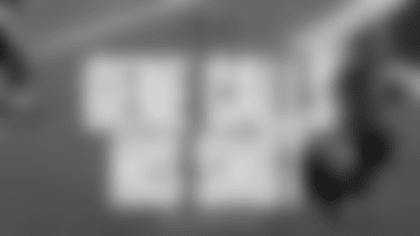The Tampa Bay Buccaneers will report for training camp on Friday and begin practice on Saturday. With 80 players, dozens of practices, the addition of pads and the suddenly urgent competition for jobs, camp storylines will emerge quickly.
There will be standouts and strugglers and depth-chart movers. There will be, unavoidably, injuries, hopefully all falling into the minor category. Offensive and defensive tendencies will take shape as the coaching staff determines what is working and what still needs work. The roster will be whittled down.
And, without a doubt, somebody you were not expecting will make a name for himself during the three weeks of training and four weeks of preseason play. It's not a question of whether or not this will happen - it occurs every summer, in every NFL camp - but simply who will make it happen.
Some players catch an early camp buzz and that proves to be the extent of it. Perhaps enough eyes are opened to lead to a practice-squad spot or a second chance with another team. Wide receiver Mario Urrutia followed that path in last year's Buccaneer camp, and now he's back in 2010 with another chance to catch on.
Others, however, turn that buzz into permanent background noise, and a more permanent spot on the team. Two years ago, cornerback Elbert Mack arrived in Bucs camp under the league-wide shadow of his former Troy teammate, first-round Buffalo Bills cornerback Leodis McKelvin. Mack was an undrafted free agent but he quickly proved that McKelvin wasn't the only NFL-quality player in that Trojan secondary. The feisty Bucs corner now has two NFL seasons under his belt and will once again battle for the nickel back job in 2010.
There are countless stories such as these in Buccaneers history. Some involve undrafted rookie free agents like Mack who defy the odds. Others are journeymen who finally find a foothold, or returning veterans who carve out a much bigger role than expected, or little-hyped free agent additions who prove to be diamonds in the rough.
As the Bucs get set for the 35th training camp in franchise history, here's a short list of some former summer standouts of fairly recent vintage who made the most of their camp opportunities. This is by no means an exhaustive list of players who have fallen into that category, but rather a representative sampling of the sort, and perhaps a preview of the next out-of-nowhere stars about to emerge.
**
WR Karl Williams, 1996
There was quite a bit of noise surrounding the Buccaneers' 1996 training camp, the first under new Head Coach Tony Dungy.
There was a whole new staff, of course, including eventual legend Monte Kiffin at the defensive reins. There was a tax referendum regarding extensive community improvements, including a new stadium. Errict Rhett was holding out. Trent Dilfer was exchanging harsh words with iconic Miami Dolphins Head Coach Jimmy Johnson.
Very quietly, unknown wide receiver Karl Williams out of tiny Texas A&M-Kingsville (the home of former Redskins great Darrell Green when it was still called Texas A&I) went about the business of establishing himself as a player to be watched.
It wasn't easy for Williams, who started quite a ways down an 11-man receiver depth chart. He strained a shoulder early on and missed several practices. He later dislocated a finger and missed a preseason game. Meanwhile, fellow hopefuls Larry Ryans and Marvin Marshall performed well and were the first names thrown about as possible replacements when starter Horace Copeland was lost to a knee injury in the second preseason game.
But when Williams did get a chance to practice, he caught Dungy's eye right away. Dungy knew that the soft-spoken receiver actually came from an impressive and tough program at Kingsville and he noticed a strong work ethic right away. Williams ran his routes precisely - he was often described that summer as being polished and mature for a rookie from a small school - and he very willingly blocked.
Copeland's injury opened a spot for one of the young receivers, but Williams hadn't caught a pass in the Bucs' first two preseason games, one of which he missed due to the finger injury. On the eve of the third preseason contest, in Pittsburgh, the St. Petersburg Times tabbed Williams as one of a handful of players that desperately needed to make an impression in the game, with the first round of cuts looming.
Williams did just that, catching three passes for 37 yards, the first one from starting quarterback Trent Dilfer as the pair converted a third-and-12 in the first quarter. That performance certainly helped the young pass-catcher, but the truth is he had already sold Dungy and his staff with his work on the practice field.
Marshall was relegated to the practice squad. Ryans made the team to start the season but was gone after three weeks. Williams lasted eight years with the Buccaneers, played in 115 games and is the team's all-time leader in punt return yards and touchdowns. He was a role player on offense that first season, catching 22 passes, but by the end he had emerged as a dynamic return man and had even posted the second punt return TD in team history.
Karl essentially chanted the mantra of the undrafted free agent when, as the final cuts loomed, he looked back on his attempts to make the team. "I knew my time was real short and I had to come in and make plays," he said. "Your heart beats about 100 times a second, but you have to go out and execute plays and hopefully things will be alright."
**
TE Todd Yoder, 2000
Like Williams, Yoder began his first NFL exploring the meaning of the word "depth" in depth chart. In the case of the young tight end out of Vanderbilt, though, it was almost ridiculous.
Tampa Bay brought seven tight ends to the start of that camp in 2000, and there's only one line on the depth chart for that position. Thus, someone had to be seventh, and that someone was Yoder, who was only in camp because Buccaneer scouts had gone to Vandy to look at linebackers and noticed a supposed "non-prospect" doing some good things on the other side of the ball.
Worse, this was the quote from Dungy as camp began for a team that had finished five points shy of the Super Bowl the year before: "It's going to be very hard for rookies and young guys to make the team this year."
That year, however, the Bucs planned to pound the ball on offense and were going to utilize an H-back. In a way, that put the tight ends and fullbacks into one big group and increased the number of spots available overall. Yoder took advantage, proving that he was willing to throw any block that was asked of him while also displaying the soft hands that had first caught the scouts eyes.
It didn't hurt, either, when the games began and Yoder showed up repeatedly. He caught four passes for 35 yards despite splitting time with so many H-back candidates and also made good on his goal to make an impact on special teams, notching two tackles. Best of all, he caught the game-winning touchdown pass with less than two minutes left against Washington on a 13-yard strike from Joe Hamilton in the Bucs' preseason opener.
As it turned out, Yoder would prove to be one of the team's best special teams players for the next four years. He notched 44 kick-coverage stops from 2000-03, blocked a punt versus Baltimore in 2001, returned another blocked punt for a touchdown against Cincinnati that same year and deflected a third punt the following year versus Carolina. He won a Super Bowl ring with the Buccaneers in 2002, racking up five special teams tackles during the playoffs.
Yoder's run with the Buccaneers wasn't as long as Williams', but his departure wasn't the end of his time in the NFL. Yoder spent one season in Jacksonville, starting eight games and catching a career-high 14 passes, then settled for the next four years with the Washington Redskins, once again excelling on special teams. He is currently a free agent as camps begin in 2010, but if he catches on anywhere, he will certainly know how to make the most of it.
**
K Michael Husted, 1993
Until Martin Gramatica passed him in 2003, Michael Husted was the all-time leading scorer in Tampa Bay's franchise history. In July of '03, though, Husted was the "longest shot," as one columnist put it, to emerge from a four-man race for the Bucs' kicking job.
Before the 1992 season, new Head Coach Sam Wyche had ill-advisedly let tested kicker Steve Christie go unprotected in Plan B free agency, providing the avenue for Christie to bolt to Buffalo. The Bucs responded by swiping Ken Willis from Dallas in the same manner, but Willis didn't prove to be the accurate kicker the team hoped he would be. Eventually, the Bucs cut Willis and signed up 36-year-old Eddie Murray, who was decidedly more accurate but painfully short on kickoffs.
Murray came to camp with the Bucs the following summer, but it was clear that the job was up for grabs. Wyche knew he could count on Murray's accuracy but wanted more distance on his kickoffs and figured he could get that from seventh-round draft pick Daron Alcorn or World League vet Tracy Bennett. Or maybe Husted, the undrafted rookie straight out of the University of Virginia.
Wyche held many camp practices at night that summer at the University of Tampa, and he often ended those sessions with kicking competitions where the four competitors would take turns. Through two weeks of camp and one preseason game, however, no leader had emerged. It didn't help that there were no field goals to attempt in the opening game against Denver. Bennett and Husted got one kickoff each, both good, and Alcorn kicked the only extra point try.
Though Wyche never identified a leader before Game Two, it's logical to assume that Husted had begun to emerge on the practice field, because the coach put his alternating-kickers plan on hold at Atlanta and, at the last minute, decided to let the Virginia rookie handle everything. Husted made one field goal, missed another and blasted several kickoffs deep.
Three days later, the team released Alcorn, who had a strong leg but had been erratic. Husted and Bennett had been about as good on kickoffs (Husted usually hitting it a bit higher, Bennett a bit longer) and had made more of their practice field goal attempts. At this point, Wyche also made it clear that, with league rosters expanding that year from 47 to 53 players, he might consider keeping two kickers.
There's little doubt that, at this point, the Bucs had begun to think they had something special in their long shot from Virginia. Bennett was released two days after Alcorn. In the third preseason game, against Buffalo at Orlando's Citrus Bowl, Husted got the first two field goal tries and hit from 37 and 43 yards out. Murray got one try and also connected from 38. Husted continued to blast his kickoffs deep.
After the game, Wyche confirmed that Husted had done enough to win a roster spot, though at this point it was possible the team would still keep both remaining kickers. The job became Husted's alone two days after the Buffalo game when Murray was waived. "We're set with Michael Husted," said Wyche. "We think he will have a long career, like Jim Breech and Eddie Murray."
Husted didn't quite match Murray's 19 seasons in the NFL or Breech's 14, but he did indeed enjoy a substantial career, kicking nine seasons for the Buccaneers, Raiders, Redskins and Chiefs. The first six of those campaigns were in Tampa, where he racked up 502 points, still the second-highest mark in franchise history.
**
LB Shelton Quarles, 1997
Quarles was as low-profile a prospect as Williams, Yoder or Husted when Bucs camp began in 1997, but he was not a rookie. In fact, it was his winding path to Tampa that probably made him seem like even more of a long shot, if anyone was paying much attention. Much of the focus at the onset of that camp, Dungy's second, was on rising defensive stars like Warren Sapp, Derrick Brooks and John Lynch and the viability of Trent Dilfer as the team's leader.
Quarles had first tried the NFL with the Miami Dolphins in 1994 as an undrafted free agent out of Vanderbilt. By his own admission, he was a little too self-satisfied in that first go-around, and was quite surprised at his release at the end of the preseason. He tried the Canadian Football League next and played two seasons for the British Columbia Lions, and even worked for awhile at a printing press in Memphis.
Mark Dominik, now the Bucs' general manager and then a pro personnel assistant, found Quarles in Canada and brought him to Tampa for another try in the NFL, though it's fair to say that the player's signing on March 21 was greeted with little fanfare.
It didn't take long for the speedy and hard-hitting linebacker to raise his profile in training camp, however. He exhibited non-stop hustle on the practice field and was a dynamo on special teams. Coaches had wondered during the offseason if Quarles would look as good in pads as he did in non-contact work, but by the second week of camp Dungy was calling him, "a pleasant surprise." When he made an impressive stop on a third-and-one play against Washington in the preseason opener, he was officially on the radar.
The Bucs were set at the three starting linebacker positions with Brooks, Hardy Nickerson and Rufus Porter, but had mostly inexperienced players fighting to back them up. Quarles was slotted in as the backup to Brooks on the weak side, which given Brooks' iron man tendencies was not going to lead to a lot of regular-season playing time.
That didn't matter at the time to Quarles, who was determined to stick his second time around in the NFL, and willing to concentrate on special teams to do so. He became so proficient at that aspect of the job that, not only did he win that spot on the 53 man roster, he was serving as a game day captain by midseason.
That year, Quarles led the Buccaneers in special teams tackles with 16 and also accounted for both of the teams' fumble recoveries in the kicking game. He actually had a very good shot to replace the departed Porter on the strong side the following season but was slowed by a training camp injury and the job went to Jeff Gooch. Quarles simply dominated on special teams again, leading the team with 20 stops, then won the strongside job in 1999. He held onto that one until 2002, when he moved to middle linebacker, made the Pro Bowl and started for the Buccaneers' championship team.
By the end of his 10-year Buccaneer career (1997-2006), Quarles had 985 tackles, the fourth-highest total in franchise history. Now a pro scout in the Bucs' player personnel department, Quarles is also remembered as one of the best special teams players in team annals.
**
DE Marcus Jones, 2000
Our last example differs even more from the trio of rookie free agents that began the list. The Marcus Jones that reported to training camp in 2000 was heading into his fifth season with the team and was on his second position, having started out as a defensive tackle. He was also a former first-round draft pick, as the Bucs had tabbed him and defensive end Regan Upshaw in the opening stanza of Dungy's first draft.
Jones' first four seasons in the league had been a bit enigmatic. He had only one sack in his first three seasons in the league, and his second year was interrupted by ankle injuries. In 1998, the former first-rounder had been relegated mostly to special teams and occasional reserve snaps at defensive tackle.
In 1999, however, the coaching staff shifted the 6-6, 280-pound Jones from the inside to end and his career finally started to take off. Playing mostly as the third end - he did start four games due to injuries to others - he finished second on the team to Warren Sapp with 7.5 sacks and helped the Bucs reach the 1999 NFC Championship Game.
It was the following summer, however, when Jones really broke out. He came into the 2000 camp still behind starters Steve White and Chidi Ahanotu, both of whom would once again make the opening-day roster. It was an improvement - he said he was running with the fourth team when camp began in 1999 and was fearful of being cut - but not yet where he wanted to be. Already a chiseled specimen, he reported to the 2000 camp in outstanding overall condition and his healthiest ankles in years. After overcoming an early-camp groin strain, he started to hit his stride.
In 1999, Jones had proven he could help the team on either the right or left side, and that actually hampered his chances to crack the starting lineup a bit. He was a valuable reserve to Ahanotu on the left and White on the right. Jones insisted he was going to push to be a starter during camp. "I'm going to make that decision very hard," he said. "That's my job right now."
Jones ended up doing his job so well that he couldn't be kept out of the starting lineup. He took over on the right end for White and opened all 16 games during the regular season. Moreover, he had his best pass-rushing season yet, racking up 13.0 sacks to make him an incredible compliment to Sapp and his team-record 16.5 QB takedowns. Jones and Sapp remain the only pair in team history to each surpass 13 sacks in the same season.
In the process, Jones earned a lucrative contract extension, though he would spend just one more season with the Buccaneers and never again reach the same heights.
























